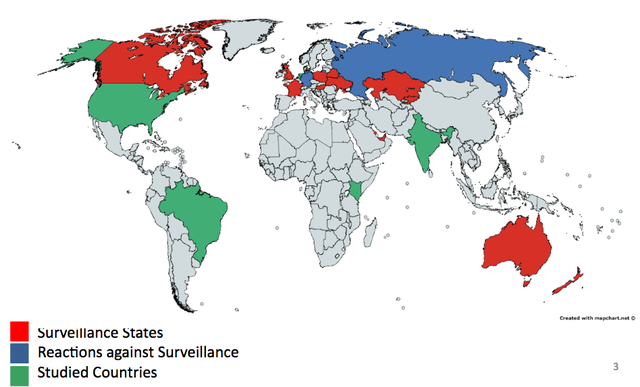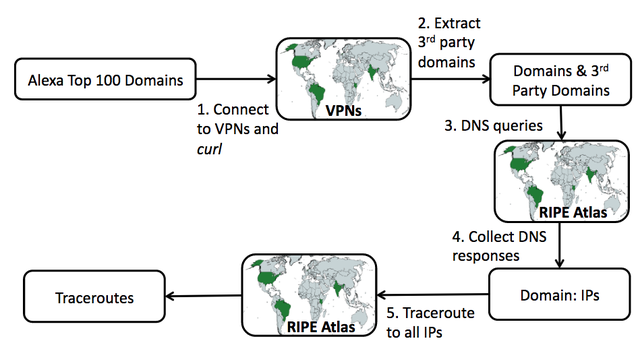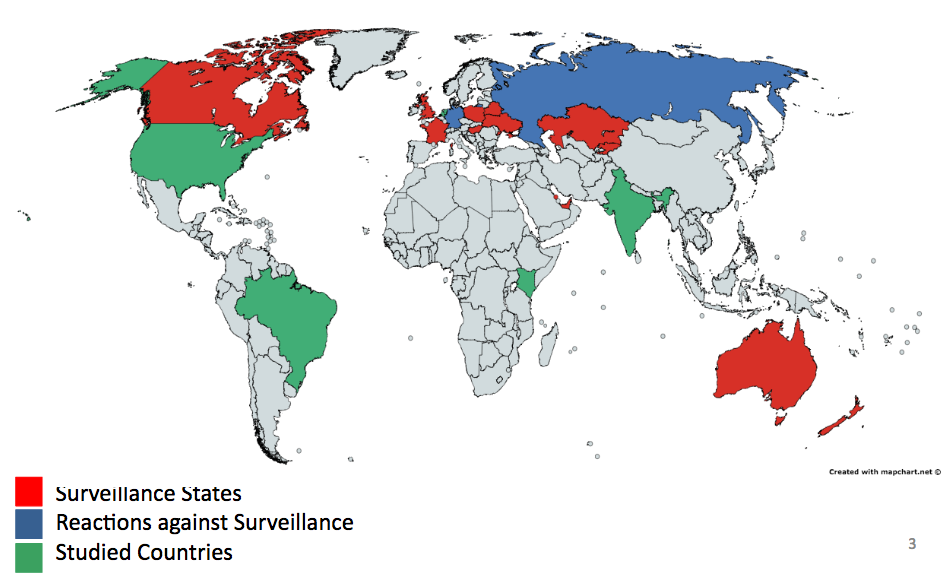An increasing number of countries are passing laws that facilitate the mass surveillance of their citizens. In response, governments and citizens are increasingly paying attention to the countries that their Internet traffic traverses. In some cases, countries are taking extreme steps, such as building new IXPs and encouraging local interconnection to keep local traffic local. We find that although many of these efforts are extensive, they are often futile, due to the inherent lack of hosting and route diversity for many popular sites. We investigate how the use of overlay network relays and the DNS open resolver infrastructure can prevent traffic from traversing certain jurisdictions.
Introduction
Since 2013, Brazil has taken significant steps to build out their networking infrastructure to thwart nation-state mass surveillance. For example, the country is deploying a 3,500-mile fiber cable from Fortaleza, Brazil to Portugal; they’ve switched their government email system from Microsoft Outlook to a state-built system called Expresso; and they now have the largest IXP ecosystem in the world. All of these measures aim to prevent the country’s Internet traffic from traversing the United States, thereby preventing the United States from conducting surveillance on their citizens’ data. But Brazil isn’t the only country that has concerns about their Internet traffic passing through the United States. Deutsche Telekom lobbied for tougher privacy protection by keeping German traffic within its national borders. Canadian traffic has been found to routinely pass through the United States, which is a violation of Canadian network sovereignty. Russian president Putin has called for “better protection of communication networks” and passed a law that requires foreign companies to keep Russian users’ data on servers inside the country.

Figure 1: World map showing the current state of surveillance. The highlighted countries are just a sampling and not an exhaustive analysis of surveillance states
To quantify which countries Internet traffic traverses and measure how successful any particular country might be at detouring its traffic around known surveillance states, we actively measured and analyzed the traffic originating in five different countries: Brazil, Netherlands, Kenya, India, and the United States.
- First, to understand the current state of transnational routing (the “status quo”), we measured the country-level traffic paths for the Alexa Top 100 domains in each respective country using RIPE Atlas probes and the MaxMind geo-location service.
- Next, we measured how successful clients in Brazil, The Netherlands, Kenya, India, and the United States might be at avoiding other countries of interest using open DNS resolvers and using an overlay network.
Please see below the method used for the measurement study.

Figure 2: Method used for the measuremetn study experiement
The rest of this post summarizes these two parts of the study and highlights some of the results.
The Status Quo: Even Local Traffic Can Detour through Surveillance States
Despite the extreme efforts of certain countries to “keep local traffic local”, and in particular to avoid having traffic traverse the United States, our measurement study indicates that these goals have not yet been reached, for two reasons:
- Lack of domain hosting diversity and
- Lack of routing diversity.
Lack of Hosting Diversity
We find that hosting for many popular websites lacks diversity. We found that about half of the Alexa Top 100 domains are hosted in a single country; in these cases, a user cannot avoid the domain’s hosting country when accessing it. In many cases, even popular local websites are hosted outside the country where citizens are trying to access them. For example, more than 50% of the top domains in Brazil and India are hosted in the United States; in total, about 50% of the .br domains are hosted outside Brazil. More hosting diversity, as could be enabled with CDNs, would allow for the potential to avoid more countries more often.
Lack of Geographic Diversity
Internet paths also lack geographic diversity: about half of the paths originating in Kenya to the most popular Kenyan websites traverse the United States or Great Britain. Much of this phenomenon is due to “tromboning,” whereby an Internet path starts and ends in a country, yet transits an intermediate country; for example, about 13% of the paths that we explored from RIPE Atlas probes in Brazil to the top domains in Brazil trombone through the United States. More than 50% of the paths from the Netherlands to their top domains transit the United States, and about half of Kenyan paths traverse the United States and Great Britain.
Towards User-Controlled Routing Detours
We next asked whether clients could take advantage of the fact that many popular websites are geo-replicated, coupled with a client’s ability to selectively “bounce” packets through overlay nodes, might give some users opportunities to avoid certain countries. We studied whether users could exploit open DNS resolvers to discover hosting diversity, and overlay network relays to intentionally introduce routing detours. Previous work in overlay networks, such as RON, tries to route around failures, whereas our work tries to route around countries. Our results show that in some cases, users can select paths to specifically avoid certain countries; in cases where local traffic leaves the country only to return (a phenomenon sometimes called “tromboning”), the use of local relays can sometimes ensure that local traffic stays within the country. For example, without these techniques, Brazilian traffic transited Spain, Italy, France, Great Britain, Argentina, Ireland (among others). Using even a modest overlay network deployment of 12 relays across 10 countries (Brazil, United States, Ireland, Germany, Spain, France, Singapore, Japan, South Korea, and Australia), clients in Brazil could completely avoid these countries for the top 100 domains. The overlay network can also be used to keep local traffic local; the percentage of tromboning paths from Brazil decreases from 13.2% of domestic paths to 9.7%.
Unfortunately, some of the more prominent surveillance states are also some of the least avoidable countries. Most countries depend highly on the United States for connectivity to other locations on the Internet. Neither Brazil, India, Kenya, nor the Netherlands can completely avoid the United States with the country avoidance techniques. The inability of these techniques to successfully avoid the United States typically results from the lack of hosting diversity for many websites, which are solely hosted in the United States. Using the overlay network, both Brazilian and Netherlands clients were able to avoid the United States for about 65% of sites; even in these cases, the United States is completely unavoidable for about 10% of sites. Traffic from Kenya can avoid the United States for only about 40% of the top domains. On the other hand, the United States can avoid every other country for all sites, with the exception of France and the Netherlands which the United States can nonetheless avoid for 99% of the top 100 domains.
More Information and Next Steps
This work was presented at RIPE 73. Please refer to the video and the slides with many more images illustrating our findings. A more detailed write-up is available on the RANSOM project website. Encouraged by the ability to use overlay networks to avoid surveillance states in certain cases, we have built a RANSOM prototype. We welcome feedback on this project as we embark on the next steps.


Comments 0
The comments section is closed for articles published more than a year ago. If you'd like to inform us of any issues, please contact us.